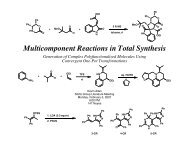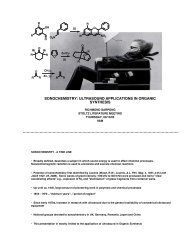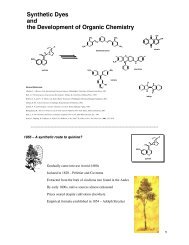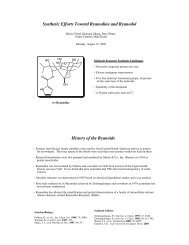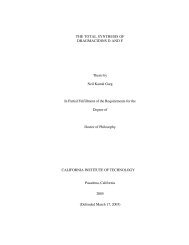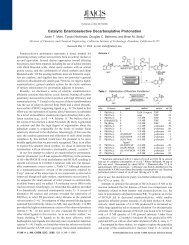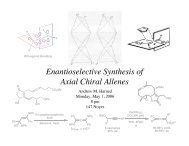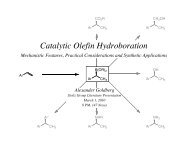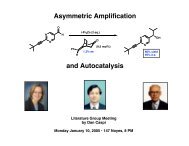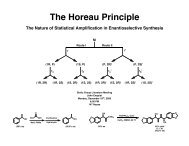Horeau Principle - The Stoltz Group
Horeau Principle - The Stoltz Group
Horeau Principle - The Stoltz Group
- No tags were found...
Create successful ePaper yourself
Turn your PDF publications into a flip-book with our unique Google optimized e-Paper software.
<strong>The</strong> <strong>Horeau</strong> <strong>Principle</strong><strong>The</strong> Nature of Statistical Amplification in Enantioselective SynthesisMRoute IRoute IIrr'(1R, P) (1S, P) (P, 2R)' (P, 2S)'r αr βr α' r β'(1R, 2R) (1R, 2S) (1S, 2R) (1S, 2S) (1R, 2R)' (1S, 2R)' (1R, 2S)' (1S, 2S)'<strong>Stoltz</strong> <strong>Group</strong> Literature MeetingJohn EnquistMonday, December 18 th , 20068:00 PM147 NoyesOHOEtO OEtNaH, PhMePurificationHydrolysisOHOOOHSnBu 3Pd(PPh 3 ) 4 , CuClCuCl 2 , DMSO, 60 °COOOHOHOO(60% ee)(86.5% ee)88% ee 82% yield8 : 1 dr(99.2% ee)
<strong>The</strong> <strong>Horeau</strong> <strong>Principle</strong>: A Statistical Basis for Asymmetric AmplificationI.) Origins and explanation of the <strong>Horeau</strong> <strong>Principle</strong>.A.) Wolfgang Langenback's observations.B.) <strong>Horeau</strong>'s original experiments and conclusions.C.) Critical assumptions, costs, and guiding concepts of <strong>Horeau</strong>'s work.II.) <strong>The</strong> <strong>Horeau</strong> <strong>Principle</strong> via chemical duplication.A.) Duplication as a method of chiral resolution or enantioenrichment.B.) Applications of duplication to the elucidation of substrate ee.C.) Duplications and their application to synthesis.III.) Extensions of the <strong>Horeau</strong> <strong>Principle</strong> beyond duplication.A.) <strong>The</strong> <strong>Horeau</strong> <strong>Principle</strong> via multiple enantioselective catalysis.B.) Adding complexity to the <strong>Horeau</strong> <strong>Principle</strong>.IV.) Conclusions.Reviews:Duplication and purification - Jacques, J.; Collet, A.; Wilen, S. H. Enantiomers, Racemates and Resolution, 1981, p. 430-434.<strong>The</strong> <strong>Horeau</strong> <strong>Principle</strong> explained - Rautenstrauch, V. Bull. Soc. Chim. Fr. 1994, 131, 515-524.Double Asymmetric synthesis - Baba, S. E.; Sartor, K.; Poulin, J.; Kagan, H. Bull. Soc. Chim. Fr. 1994, 131, 525-533.In the context of non-linear effects - Girard, C.; Kagan, H. Angew. Chem. Int. Ed. 1998, 37, 2922-2959.<strong>The</strong> historical perspective - Heller, G. Angew. Chem. Int. Ed. 2000, 39, 495-499.Mathematical treatment and assumptions - Chandrasekhar, S. 2005, 31, 779-783.
Langenback's Observations: <strong>The</strong> Origin of the <strong>Horeau</strong> <strong>Principle</strong>An Idea Before its Time• Langenback's original publication in 1936 postulated:"With every synthesis of an optically active compound from inactive starting materials, a degredation in optical puritytakes place... <strong>The</strong> infinite repetition of these processes over a geological time period would have led to a completeloss of optical activity... if the degredation were not compensated for by an increase in optical purity in a differentprocess."• To understand and indentify this phenomenon, Langenback investigated a simple dimerization process:OO2OHClOClOOO2 HClL – menthol(0 - 100% ee)• Analysis of the optical rotation of the product bis-ester revealedunusal behavior. Product rotation varied as a function of theee of L-menthol.• No stereocenters were formed... What factors influence opticalrotation here?Heller, G. Angew. Chem. Int. Ed. 2000, 39, 495-499.Langenbeck, W. Z. Phys. Chem. A 1936, 177, 401-408.
Langenback's Observations: <strong>The</strong> Origin of the <strong>Horeau</strong> <strong>Principle</strong>An Idea Before its Time• Reaction between scalemic l-menthol and oxalyl chloride is expected toproduce both homochiral and heterochiral diastereomers. <strong>The</strong> homochiralproduct is afforded as a pair of enantiomers. <strong>The</strong> heterochiral product is meso.OHClOOClk l-monoOOOClk l,lk l,dOOOO(l,l)-bismenthyloxylate"If it were possible to separate the meso ester quantitatively, thenit would be expected that even with the use of l-menthol with a lowee value, an increase in the optical purity of the product would beobserved."OOOO(l,d)-bismenthyloxylateOHClOOClk d-monoOOOClk d,lk d,dOOOO(d,l)-bismenthyloxylateOOOO(d,d)-bismenthyloxylateHeller, G. Angew. Chem. Int. Ed. 2000, 39, 495-499.Langenbeck, W. Z. Phys. Chem. A 1936, 177, 401-408.
<strong>Horeau</strong>'s Experiments: Statistical Enantiomeric EnrichmentDimerization as a Resolution Technique• In 1973, <strong>Horeau</strong> performed experiments very similar to Langenbeck's duplications, but with the aid of separation techniques.OOEtO OEtOH O ONaH, PhMeOOO(60% ee)HomochiralHeterochiral2.10 :1• Dimerization of a nonracemic molecule throughan achiral linker provided a mixture ofdiastereomeric products.• Separation of these diastereomers followedby liberation of the monomers yielded twodifferent mixtures of the starting material.• <strong>The</strong> homochiral diastereomer affordedenantioenriched monomer, whereas theheterochiral diastereomer afforded onlyracemic monomer.HydrolysisOHHydrolysisOH67.7% yield(86.5% ee)32.2% yield(0% ee)Vigneron, J. P.; Dhaenes, M.; <strong>Horeau</strong>, A. Tetrahedron, 1973, 29, 1055-1059.Rautenstrauch, V. Bull. Soc. Chim. Fr. 1994, 131, 515-524.
<strong>Horeau</strong>'s Experiments: Statistical Enantiomeric EnrichmentMath and <strong>The</strong>ory• For any scalemic mixture composed of molecules baring a single chiral center, the respective enantiomers are representedby the letters R and S. An achiral, bifunctional duplication reagent is represented by A.• If the scalemic mixture is enriched with the R enantiomer,the total composition of R in the mixture can be represented asx, while the total composition of S is 1-x (where R+S=1).• Criticial Assumptions:- <strong>The</strong> outcome of the first reaction must have no influenceupon the second reaction. This means no chiral recognitionbetween RA or SA and either incoming monomer.- <strong>The</strong>re must be no difference in rate between enantiomersduring the formation of RA or SA.- <strong>The</strong>re must be no interference by side reactions.- Reactions must be irreversible.• Following the above assumptions, we can conclude:RxS(1-x)k mAAk mRAxSA(1-x)RSRSk dk dk dk dRRRSSRSSx 2x•(1-x)(1-x)•x(1-x) 2ee p =Homochiral Yielddr = =er p =Heterochiral YieldRR – SSRR + SS=x 2 – (1-x) 2x 2 + (1-x) 2RRSS = x 2(1-x) = x2 (1-x)x 2 + (1-x) 22•x•(1-x)2excess of the starting material, we can find alternativeexpressions for ee p and dr:• If we take the value ee i to be the initial enantiomeric2•ee= (er i ) 2 ee p = i1 + (eedr =i ) 21 + (ee i ) 2 1 – (ee i ) 2Vigneron, J. P.; Dhaenes, M.; <strong>Horeau</strong>, A. Tetrahedron, 1973, 29, 1055-1059.Rautenstrauch, V. Bull. Soc. Chim. Fr. 1994, 131, 515-524.
<strong>Horeau</strong>'s Experiments: Statistical Enantiomeric EnrichmentCosts and Benefits• <strong>The</strong> ee of the dimer increases beyond that of the monomer quickly. This is an example of positive nonlinear behavior.er p = = (er i ) 2= RRSSRS2er p ≥ er i(for all R > S)ee p =2•ee i1 + (ee i ) 2• <strong>The</strong> de (and hence dr) of the dimer increases more slowly, with high dr only achieved at large ee i values.dr =1 + (ee i ) 2 de = (ee i ) 2 ≤ ee i for 0 ≤ ee i ≤ 11 – (ee i ) 210.9• <strong>The</strong> inherent cost of this duplicationtechnique is a loss in yield. <strong>The</strong>removed meso diastereomer is halfcomposed of the desired enantiomer!Yield loss =11 + drValues • 100%0.80.70.60.50.4ee of the dimerde of the dimerYield lost0.30.2Vigneron, J. P.; Dhaenes, M.; <strong>Horeau</strong>, A.Tetrahedron, 1973, 29, 1055-1059.Rautenstrauch, V. Bull. Soc. Chim. Fr.1994, 131, 515-524.0.100 0.1 0.2 0.3 0.4 0.5 0.6 0.7 0.8 0.9 1(ee of the monomer) • 100%
Enantiomeric Enrichment via DuplicationApplications and Synthesis• Synthesis and enantioenrichment of diisopinocamphenylborane from scalemic (α)-pinene.B 2 H 60 °CTHFBHHB2 2ee i ee p91.6 99.092.0 99.0ee calc99.699.7(<strong>Horeau</strong> <strong>Principle</strong> behavior observed despite newly forming chiral center)84.0 98.398.4B 2 H 60 °CTHFHB1. 1-Pentene2. PhCHO75 °C, neat(86.3% ee i )Brown, H. C.; Singaram, B. J. Org. Chem. 1984, 49, 945-947.Prabhakar, K.; Brown, H. C. J. Org. Chem. 1985, 50, 3203-3206.244% yield(98.5% ee i )• Dimerization of (S)-methylbenzylamine was used in order to assay ee without need for a chiral auxiliary.Ph(Cl 3 CO) 2 COPhOPh• 1 H NMR showed 99:1 dr in favor of thehomochiral diastereomer for (+)-methylbenzylamine.NH 2NEt 3 , CH 2 Cl 2NHNH• (±)-methylbenzylamine gave a 1:1 dr.• <strong>The</strong> amine ee i was determined to be 99.1%Grotjahn, D.; Joubran, C.; Tetrahedron: Asymmetry 1995, 6, 745-752.
Enantiomeric Enrichment via DuplicationApplications and Synthesis• Low selectivity carboalumination produced substrates with modest ee values. Duplication made them synthetically useful.HOOCNNCOPhH, DABCO60 °C, 4 hROONHHNOR(74% ee i )Huo, S.; Negishi, E. Org. Lett. 2001, 3, 3253-3256.43% yield(no reported dr)(93.0% ee)OCalculated3.4 : 1 dr95.6% ee• <strong>Horeau</strong>–type duplications are most effective when they are transparent to a synthetic route, or else can play a roll in the synthesis.OClODMAP, PyO OHO OOOOCl CH 2 Cl 2OO O(80% ee i )O87% yield4.6 : 1 dr(97.5% ee)OCalculated4.5 : 1 dr97.6% eeDowex 50WHOOOH70 °CMeOH / H 2 OOHD'Arrigo, P.; Servi, S. J. Org. Chem. 1997, 62, 6394-6396.82% yieldOOOHNHOHOH39.1% overall yield97.5% ee
Enantiomeric Enrichment via DuplicationDuplication without Achiral Linkers• <strong>The</strong> total synthesis of (–)-Wodeshiol by Corey benefits from <strong>Horeau</strong>-type ee amplification during the key dimerization:OOBr(R)–CBS catalystcatechol boraneOOHBr1. t-BuLi,-78 °C, Et 2 OOOHSnBu 3OPhMe / CH 2 Cl 2O2. Bu 3 SnClO84% yield(88% ee i )84% yieldOHOHOOSnBu 3Pd(PPh 3 ) 4 , CuClOOCuCl 2 , DMSO, 60 °CO(88% ee i )Han, X.; Corey, E. J. Org. Lett. 1999, 1, 1871-1872.O82% yield8.0 : 1 dr(99.2% ee)OHCalculated7.9 : 1 dr99.2% ee• Derivitization and coupling of a common intermediate to boost modest ee:MeO 2 COHTHFAcOOHR = TMBDS(80% ee i )PhO 2 SHoffmann, R.; Schopfer, U. Helv. Chim. Acta. 2002, 85, 4424-4441.ORn-BuLiTHF1. Ac 2 O2. Na/HgMeO 2 C88% yield(dr not reported)≥ 98.0% eeCalculated4.5 : 1 dr97.5% eeOR
Enantiomeric Enrichment via DuplicationControversy over the Synthesis of Carpenter Bee Hormone• 1981: Mori and Tanida report the total synthesis of four stereoisomers of 2,8-Dimethyl-1,7-dioxaspiro[5,5]undecane.OCO 2 EtYeastOHCO 2 Et(92% ee i )OOOO(+)-1 (–)-1OO(±)-2• 1984: Isaksson and coworkers separate the four naturally occuring stereoisomers via liquid chromatography.<strong>The</strong>ir optical rotation values do not match those of Mori et al. exactly.[α] 24Mori ValuesIsaksson Values(+)-1 (–)-1 (+)-2 (–)-2+ 51.7° - 51.6° – –+ 44.6° - 44.3° + 44.0° - 44.6°"We thus conclude that our isolated enantiomers are at least 98% optically pure.Mori and Tanida reported [larger] specific rotations... although their chiral startingmaterial was of only 92% ee... <strong>The</strong> reason for this is not clear to us."• 1986: Mori and Tanida report multiple (re)syntheses of (+)-1 and (-)–1 in response to Isaksson's paper."[Isaksson] challenged our higher values, because we employed [starting material] of only 92% ee... Apparentlythey thought that [this] should yield (+)-1 of 92% ee."Mori, K.; Tanida. Tetrahedron, 1981, 37, 3221-3225.Isaksson, R.; Liljefors, T. J. Chem. Soc. Chem. Commun. 1984, 137-138.Mori, K.; Watanabe, H. Tetrahedron, 1986, 42, 295-304.
Enantiomeric Enrichment via DuplicationControversy over the Synthesis of Carpenter Bee Hormone• 1981, 1986: Total synthesis and reexamination of 2,8-Dimethyl-1,7-dioxaspiro[5,5]undecane by Mori.OCO 2 EtYeastOHCO 2 Et(92% ee i )Mitsunobu reactionandFurther elaborationOPG(85% ee i )IOPGOCO 2 Et1. NaH, THF2. BuLi, THF3.OPG(X% ee i )IOPGOCO 2 Et1.(X% ee i )K 2 CO 3 , Acetone2. KOH (aq) , MeOHIOPG O OPG<strong>Horeau</strong> Type DuplicationAlcoholConfig.ExperimentX% ee i [α] 24 % ee p drCalculated% ee p drProtecting<strong>Group</strong>CleavageS92 - 51.6° 99.3 9 : 199.6 12 : 1RR100 + 59.2° 100 N/A85 + 58.7° 97.2 6.4 : 1100 N/A98.6 6.2 : 1OOOO"In conclusion... the specific rotations reported for 1 and 2 by Isaksson et al. must be inerror. <strong>The</strong> reason for this is not clear to us."(–)-1(±)-2Mori, K.; Tanida. Tetrahedron, 1981, 37, 3221-3225.Isaksson, R.; Liljefors, T. J. Chem. Soc. Chem. Commun. 1984, 137-138.Mori, K.; Watanabe, H. Tetrahedron, 1986, 42, 295-304.
Multiple Enantioselective TransformationsRemote Stereocenter Generation and Statistical Distributions• Do <strong>Horeau</strong>-type distributions and effects play a role in the generation of two or more stereocenters from a prochiral molecule?- For the case of a molecule M bearing two nonequivalent prochiral centers labeled 1 and 2, we assume total conversionof the intermediates:r =r α=r β=[1R, P] – [1S, P][1R, P] + [1S, P][1R, 2R] – [1R, 2S][1R, 2R] + [1R, 2S][1S, 2R] – [1S, 2S][1S, 2R] + [1S, 2S]1 2MnRoute IInitial Attack at 1r(1R)n(1S)nr αr β(1R) n (2R) (1R) n (2S)(1S) n (2R) (1S) n (2S)(1R, 2R)(1R, 2S) (1S, 2R) (1S, 2S)Baba, S.; Sartor, K.; Kagan, H. Bull. Soc. Chim. Fr. 1994, 525-533.(1R, 2R) + (1S, 2S) – Diastereomer A(1R, 2S) + (1S, 2R) – Diastereomer B
Multiple Enantioselective TransformationsRemote Stereocenter Generation and Statistical Distributions• Do <strong>Horeau</strong>-type distributions and effects play a role in the generation of two or more stereocenters from a prochiral molecule?- For the case of a molecule M bearing two nonequivalent prochiral centers labeled 1 and 2, we assume total conversionof the intermediates:r =r α=[1R, P] – [1S, P][1R, P] + [1S, P][1R, 2R] – [1R, 2S][1R, 2R] + [1R, 2S]1 2MnRoute IIInitial Attack at 2r' =r α' =[P, 2R]' – [P, 2S]'[P, 2R]' + [P, 2S]'[1R, 2R]' – [1S, 2R]'[1R, 2R]' + [1S, 2R]'r β=[1S, 2R] – [1S, 2S][1S, 2R] + [1S, 2S]r'r β' =[1R, 2S]' – [1S, 2S]'[1R, 2S]' + [1S, 2S]'n(2R)'n(2S)'r α'r β'(1R)' n (2R)' (1R)' n (2S)'(1S)' n (2R)' (1S)' n (2S)'(1R, 2R)'(1R, 2S)' (1S, 2R)' (1S, 2S)'Baba, S.; Sartor, K.; Kagan, H. Bull. Soc. Chim. Fr. 1994, 525-533.(1R, 2R)' + (1S, 2S)' – Diastereomer A(1R, 2S)' + (1S, 2R)' – Diastereomer B
Multiple Enantioselective TransformationsRemote Stereocenter Generation and Statistical Distributions• Do <strong>Horeau</strong>-type distributions and effects play a role in the generation of two or more stereocenters from a prochiral molecule?- For the case of a molecule M bearing two nonequivalent prochiral centers labeled 1 and 2, we assume total conversionof the intermediates:r =r α=[1R, P] – [1S, P][1R, P] + [1S, P][1R, 2R] – [1R, 2S][1R, 2R] + [1R, 2S]R1 2MnR'Route IRoute IIr' =r α'=[P, 2R]' – [P, 2S]'[P, 2R]' + [P, 2S]'[1R, 2R]' – [1S, 2R]'[1R, 2R]' + [1S, 2R]'r β=[1S, 2R] – [1S, 2S][1S, 2R] + [1S, 2S]rr'r β' =[1R, 2S]' – [1S, 2S]'[1R, 2S]' + [1S, 2S]'(1R, P) (1S, P) (P, 2R)' (P, 2S)'r αr βr α'r β'(1R, 2R) (1R, 2S) (1S, 2R) (1S, 2S) (1R, 2R)' (1S, 2R)' (1R, 2S)' (1S, 2S)'Diastereomer A = aDiastereomer B = b• Additional definitions for the diastereomeric ratio, and a term ( i ) to weigh the relative contributions of Routes I and II:adr = such that a + b =1bBaba, S.; Sartor, K.; Kagan, H. Bull. Soc. Chim. Fr. 1994, 525-533.i =[1R, P] + [1S, P][1R, P] + [1S,P] + [P, 2R]' + [P, 2S]'
Multiple Enantioselective TransformationsRemote Stereocenter Generation and Statistical Distributions• Do <strong>Horeau</strong>-type distributions and effects play a role in the generation of two or more stereocenters from a prochiral molecule?- For the case of a molecule M bearing two nonequivalent prochiral centers labeled 1 and 2, we assume total conversionof the intermediates:r =r α=[1R, P] – [1S, P][1R, P] + [1S, P][1R, 2R] – [1R, 2S][1R, 2R] + [1R, 2S]R1 2MnR'Route IRoute IIr' =r α'=[P, 2R]' – [P, 2S]'[P, 2R]' + [P, 2S]'[1R, 2R]' – [1S, 2R]'[1R, 2R]' + [1S, 2R]'r β=[1S, 2R] – [1S, 2S][1S, 2R] + [1S, 2S]rr'r β' =[1R, 2S]' – [1S, 2S]'[1R, 2S]' + [1S, 2S]'(1R, P) (1S, P) (P, 2R)' (P, 2S)'r αr βr α'r β'(1R, 2R) (1R, 2S) (1S, 2R) (1S, 2S) (1R, 2R)' (1S, 2R)' (1R, 2S)' (1S, 2S)'• If the possibility for different stereoselectivities at each step is considered, the product ee and dr can be expressed as:ee A =([1R, 2R]+[1R, 2R]') – ([1S, 2S]+[1S, 2S]')([1R, 2R]+[1R, 2R]') + ([1S, 2S]+[1S, 2S]')=i [(1+r α)(1+r) – (1-r β)(1-r)] + (1-i) [(1+r α')(1+r') – (1-r β')(1-r')]i [(1+r α)(1+r) + (1-r β)(1-r)] + (1-i) [(1+r α')(1+r') + (1-r β')(1-r')]ee B =([1R, 2S]+[1R, 2S]') – ([1S, 2R]+[1S, 2R]')([1R, 2S]+[1R, 2S]') + ([1S, 2R]+[1S, 2R]')=i [(1-r α)(1+r) – (1-r β)(1-r)] + (1-i) [(1+r β')(1-r') – (1-r α')(1+r')]i [(1-r α)(1+r) + (1+r β)(1-r)] + (1-i) [(1+r β')(1-r') + (1-r α')(1+r')]dr =([1R, 2R]+[1R, 2R]') + ([1S, 2S]+[1S, 2S]')([1R, 2S]+[1R, 2S]') + ([1S, 2R]+[1S, 2R]')=i [(1+r α)(1+r) + (1-r β)(1-r)] + (1-i) [(1+r β')(1+r') + (1-r α')(1-r')]i [(1-r α)(1+r) + (1+r β)(1-r)] + (1-i) [(1+r β')(1-r') + (1-r α')(1+r')]Baba, S.; Sartor, K.; Kagan, H. Bull. Soc. Chim. Fr. 1994, 525-533.
Multiple Enantioselective TransformationsRemote Stereocenter Generation and Statistical Distributions• Limiting cases of Kagan's calculations for multiple chiral reactions.MRoute IRoute IIrr(1R, P) (1S, P) (P, 2R)' (P, 2S)'r αr βr αr β(1R, 2R) (1R, 2S) (1S, 2R) (1S, 2S) (1R, 2R)' (1S, 2R)' (1R, 2S)' (1S, 2S)'• Assumptions:Route I and Route II operate simultaneously and competitively, but have identical selectivities at corresponding steps.r = r' r α = r α ' r β = r β 'ee A =i [(1+r α)(1+r) – (1-r β)(1-r)] + (1-i) [(1+r α')(1+r') – (1-r β')(1-r')]i [(1+r α)(1+r) + (1-r β)(1-r)] + (1-i) [(1+r α')(1+r') + (1-r β')(1-r')]ee A =(1+r α)(1+r) – (1-r β)(1-r)(1+r α)(1+r) + (1-r β)(1-r)ee B =i [(1-r α)(1+r) – (1-r β)(1-r)] + (1-i) [(1+r β')(1-r') – (1-r α')(1+r')]i [(1-r α)(1+r) + (1+r β)(1-r)] + (1-i) [(1+r β')(1-r') + (1-r α')(1+r')]ee B =(2i - 1)(1-r α)(1+r) – (1+r β)(1-r)(1-r α)(1+r) + (1+r β)(1-r)dr =i [(1+r α)(1+r) + (1-r β)(1-r)] + (1-i) [(1+r β')(1+r') + (1-r α')(1-r')]i [(1-r α)(1+r) + (1+r β)(1-r)] + (1-i) [(1+r β')(1-r') + (1-r α')(1+r')]dr =(1+r α)(1+r) – (1-r β)(1-r)(1-r α)(1+r) + (1+r β)(1-r)Baba, S.; Sartor, K.; Kagan, H. Bull. Soc. Chim. Fr. 1994, 525-533.
Multiple Enantioselective TransformationsRemote Stereocenter Generation and Statistical Distributions• Limiting cases of Kagan's calculations for multiple chiral reactions.Mr(1R, P) (1S, P)r αr β(1R, 2R) (1R, 2S) (1S, 2R) (1S, 2S)• Assumptions:Route I and Route II are identical, or else one of the Routes dominates the reaction to the point of always occuring first:i = 1 r = r'r α = r α ' r β = r β 'ee A =(1+r α)(1+r) – (1-r β)(1-r)(1+r α)(1+r) + (1-r β)(1-r)ee A =(1+r α)(1+r) – (1-r β)(1-r)(1+r α)(1+r) + (1-r β)(1-r)ee B =(2i - 1)(1-r α)(1+r) – (1+r β)(1-r)(1-r α)(1+r) + (1+r β)(1-r)ee B =(1-r α)(1+r) – (1+r β)(1-r)(1-r α)(1+r) + (1+r β)(1-r)dr =ee B – rr – ee Adr =(1+r α)(1+r) – (1-r β)(1-r)(1-r α)(1+r) + (1+r β)(1-r)dr =(1+r α)(1+r) – (1-r β)(1-r)(1-r α)(1+r) + (1+r β)(1-r)Baba, S.; Sartor, K.; Kagan, H. Bull. Soc. Chim. Fr. 1994, 525-533.
Multiple Enantioselective TransformationsRemote Stereocenter Generation and Statistical Distributions• Limiting cases of Kagan's calculations for multiple chiral reactions.Mr(1R, P) (1S, P)rr(1R, 2R) (1R, 2S) (1S, 2R) (1S, 2S)• Assumptions:All stereoselectivities are identical, regardless of order of transformation or other existing stereocenters:i = 1r = r' = r α = r α ' = r β = r β 'ee A =ee B =dr =(1+r α)(1+r) – (1-r β)(1-r)(1+r α)(1+r) + (1-r β)(1-r)(1-r α)(1+r) – (1+r β)(1-r)(1-r α)(1+r) + (1+r β)(1-r)(1+r α)(1+r) – (1-r β)(1-r)(1-r α)(1+r) + (1+r β)(1-r)ee A =ee B =dr =2r1 + r 201 + r 21 – r 2ee p =dr =2• ee i1 + (ee i ) 21 + (ee i ) 21 - (ee i ) 2Baba, S.; Sartor, K.; Kagan, H. Bull. Soc. Chim. Fr. 1994, 525-533.
Multiple Enantioselective TransformationsRemote Stereocenter Generation and Statistical Distributions• Summary:• In the case of a double enantioselective reaction, the ee of the major (A) and minor (B) diastereomers and the dr are:ee A =ee B =dr =i [(1+r α )(1+r) – (1-r β )(1-r)] + (1-i) [(1+r α ')(1+r') – (1-r β ')(1-r')]i [(1+r α)(1+r) + (1-r β)(1-r)] + (1-i) [(1+r α')(1+r') + (1-r β')(1-r')]i [(1-r α)(1+r) – (1-r β)(1-r)] + (1-i) [(1+r β')(1-r') – (1-r α')(1+r')]i [(1-r α)(1+r) + (1+r β)(1-r)] + (1-i) [(1+r β')(1-r') + (1-r α')(1+r')]i [(1+r α)(1+r) + (1-r β)(1-r)] + (1-i) [(1+r β')(1+r') + (1-r α')(1-r')]i [(1-r α)(1+r) + (1+r β)(1-r)] + (1-i) [(1+r β')(1-r') + (1-r α')(1+r')]Substrate Control• When the selectivities for the reactions are independent of the initial reaction site (Same selectivities along Route I and II):(1+r α)(1+r) – (1-r β)(1-r)(1-r α)(1+r) – (1+r β)(1-r)ee A = ee B = (2i - 1)dr =(1+r α)(1+r) + (1-r β)(1-r)(1-r α)(1+r) + (1+r β)(1-r)(1+r α)(1+r) – (1-r β)(1-r)(1-r α)(1+r) + (1+r β)(1-r)• When the Routes and their selectivities are identical – OR – When one Route is highly favored (r ≠ r α≠ r β):dr =ee B – rr – ee A• When the selectivities are equal, and independent of all else (r = r α= r β):2r1 + ree A = ee B = 20 dr =1 + r 2 Catalyst Control1 – r 2Baba, S.; Sartor, K.; Kagan, H. Bull. Soc. Chim. Fr. 1994, 525-533.
Multiple Enantioselective TransformationsRemote Stereocenter Generation and Statistical Distributions• Amplifications originating from double enantioselective reactions upon a bis-prochrial molecule:rRoute IMRoute IIr'(1R, P) (1S, P) (P, 2R)' (P, 2S)'r αr βr α'r β'(1R, 2R) (1R, 2S) (1S, 2R) (1S, 2S) (1R, 2R)' (1S, 2R)' (1R, 2S)' (1S, 2S)'• For a situation in which the chiral catalsyt or reagent employed favors the formation of the R stereocenter.- Intial reaction creates an excess of (1R, P), (P, 2R)' relative to (1S, P), (P, 2S)'.- Futher reaction of (1R, P) favors (1R, 2R). Any (1R, 2S) produced has no effect on ee A .(<strong>The</strong> same holds for the analogous path in Route II)- Any reaction of (1S, P) generated in the first step favors (1S, 2R), minimizing (1S, 2S).(Again, also for Route II)Rautenstrauch, V. Bull. Soc. Chim. Fr. 1994, 131, 515-524.Baba, S.; Sartor, K.; Kagan, H. Bull. Soc. Chim. Fr. 1994, 525-533.
Multiple Enantioselective TransformationsSynthesis and Multiple Prochiral Centers• Obtaining enantioenriched 1,2-diols via asymmetric dihydroxylation of the corresponding terminal olefins affordedlower than anticipated ee values in some cases.Ligand(DHQD) 2 –Oxidant% ee pHOADConditionsHOOHOH-PHAL-PHAL-PYR-PYR-AQNK 3 Fe(CN) 6 85.7I 2 83.2K 3 Fe(CN) 6 95.6I 2 89.0K 3 Fe(CN) 6 84.0AlkylationConditions-AQNI 2 52.8OHLigand(DHQD) 2 –Oxidant % ee p drOO33ADConditionsOO33OHOHOH-PHAL-PHAL-PYR-PYR-AQN-AQN98.9K 3 Fe(CN) 6K 3 Fe(CN) 6 98.1I 2K 3 Fe(CN) 697.099.4I 2 70.4I 2 97.66.74.19.51.45.14.6Hoye, T.; Mayer, M. J. Org. Chem. 1998, 63, 8554-8557.
Multiple Enantioselective TransformationsSynthesis and Multiple Prochiral Centers• <strong>Horeau</strong>-type amplification of 1,2-diols via double asymmetric dihydroxylation gave much better ee values for many conditions...But at a cost.OHOnOADConditionsnOHOnOnOHOHnLigand(DHQD) 2 –Oxidant % ee p dr% ee i(calculated)% Yield lostto meso00033-PHAL-PYR-AQN-PHAL-PYRK 3 Fe(CN) 6K 3 Fe(CN) 6K 3 Fe(CN) 6I 2K 3 Fe(CN) 699.284.899.997.099.47.91.924.54.19.588.155.696.078.090.011.234.63.919.69.53-PYRI 2 70.41.441.2 41.255-PHAL K 3 Fe(CN) 6 97.6 4.6 80.0 18.0-PYR I 2 89.7 2.3 62.3 30.6Hoye, T.; Mayer, M. J. Org. Chem. 1998, 63, 8554-8557.
Multiple Enantioselective TransformationsSynthesis and Multiple Prochiral Centers• Stepwise transformations show similar mathematical behavior in the absence of substrate control.1.) Me 3 Al, (NMI) 2 ZrCl 2CH 2 Cl 22.) O 2 , CH 2 Cl 2HO79% yield(74% ee i )ZrCl 2(NMI) 2 ZrCl 21.) Me 3 Al, (NMI) 2 ZrCl 2CH 2 Cl 22.) O 2 , CH 2 Cl 2HO76% yield(74% "ee i " - At the new stereocenter)• Knowing the "local" ee values at each of the stereocenters individually allows for <strong>Horeau</strong> predictions, which canbe checked against experimental findings:CalculatedValuesee p =dr =2• ee i1 + ee2i1 + ee2 i1 – ee2 i= 95.6%= 3.4296.7% = ee p3.32 = drExperimentallyDeterminedValuesHuo, S.; Negishi, E. Org. Lett. 2001, 3, 3253-3256.
Multiple Enantioselective TransformationsSynthesis and Multiple Prochiral Centers• Stepwise transformations show similar mathematical behavior in the absence of substrate control.1.) Me 3 Al, (NMI) 2 ZrCl 2CH 2 Cl 22.) O 2 , CH 2 Cl 2HO79% yield(74% ee i )ZrCl 21.) Me 3 Al, (NMI) 2 ZrCl 2CH 2 Cl 22.) O 2 , CH 2 Cl 2HO(NMI) 2 ZrCl 276% yield(96.7% ee)3.32 drCost: 22.6% yieldPPh 3 , NBSCH 2 Cl 2BrBnOOOTsVitamin E(≥ 99% ee)95% yield(96.7% ee)(98.0% ee)• Even in cases of sequential enantioselective reactions, amplification of product ee may result.Huo, S.; Negishi, E. Org. Lett. 2001, 3, 3253-3256.
Multiple Enantioselective TransformationsApplications Beyond Amplification• Is it possible to estimate the enantioselectivity of a chiral catalyst from its racemic mixture?Cat rac• Equal opportunity to interact with either sense of the catalyst at either step leads to a racemate. In the absence of substrateinfluence, equal quantities of the two diastereomers are expected. . .CatalystscramblingCat RHomochiraldiastereomerHeterochiraldiastereomerCat RCat SCat SCat RCat SLagasse, F.; Tsukamoto, M.; Kagan, H. J. Am. Chem. Soc. 2003, 125, 7490-7491.
Multiple Enantioselective TransformationsApplications Beyond Amplification• Is it possible to estimate the enantioselectivity of a chiral catalyst from its racemic mixture?Cat rac• What would occur if, after the initial reaction, the catalyst did not release the substrate? What if it could continue to actupon the remaining prochiral site?• <strong>The</strong> heterochiral diastereomer would then be afforded only as a result of "catalyst errors", and (dr ≠ 1) would be expected.Cat RHomochiraldiastereomerHeterochiraldiastereomerCat RCat SCat SLagasse, F.; Tsukamoto, M.; Kagan, H. J. Am. Chem. Soc. 2003, 125, 7490-7491.
Multiple Enantioselective TransformationsApplications Beyond Amplification• Is it possible to estimate the enantioselectivity of a chiral catalyst from its racemic mixture?• For a single catalyst of a racemic mixture interacting with both prochiral sites of a symmetric substrate:Single CatalystAnalysis+ Cat Ree 10.5•(1+ee 1 )+ Cat Ree 10.25•(1+ee 1 ) 20.5•(1+ee 1 )(1–ee 1 )Note: ee 2 in this caserefers to the localselectivity at the secondforming center.+ Cat Ree 10.5•(1–ee 1 )0.25•(1–ee 1 ) 2• If the catalyst operates on both prochiral sites with equal selectivity, then ee 1 = ee 2 holds true.ee homo =2•(ee 1 )=dr =01 + (ee 1 ) 2For every reaction of this moleculewith Cat R there occurs acorresponding reaction ofanother molecule with Cat S .1 + (ee 1 ) 21 – (ee 1 ) 2de homo = (ee 1 ) 2Both Cat R and Cat S will affordthe same ratio of homorchiralto heterochiral products.ee 1 ≈ √(de homo )Lagasse, F.; Tsukamoto, M.; Kagan, H. J. Am. Chem. Soc. 2003, 125, 7490-7491.
Multiple Enantioselective TransformationsApplications Beyond Amplification• Is it possible to estimate the enantioselectivity of a chiral catalyst from its racemic mixture?• Guiding conditions and critical assumptions:1.) For any given substrate with two prochiral sites, a single catalyst molecule must perform both reactions (No scrambling).2.) After a single reaction, the newly formed stereocenter must have no influence on further selectivity (Zero substrate control).3.) <strong>The</strong> catalyst selectivity must be identical at both prochiral sites, regardless of the order of reaction (ee 1 = ee 2 ).PhPhOPhOPh3OPhOPh(R)– and (S)–CBSBH 3 •DMS, THFPhPhNOBBH 3RPhPhNOBH 3 BRON BRH 2 B OHPh3PhOPhPhNOBRH 2 B O O*3PhPhPhOHOH* *3PhHClMeOHPhOHBO* *3PhHBNOPhPhPhOBRO3* *PhHBNOPhPhOBRH O3PhPhPhON BRH 2 BO OPh *3Ph*Lagasse, F.; Tsukamoto, M.; Kagan, H. J. Am. Chem. Soc. 2003, 125, 7490-7491.Ph
Multiple Enantioselective TransformationsApplications Beyond Amplification• Is it possible to estimate the enantioselectivity of a chiral catalyst from its racemic mixture?• Guiding conditions and critical assumptions:1.) For any given substrate with two prochiral sites, a single catalyst molecule must perform both reactions (No scrambling).2.) After a single reaction, the newly formed stereocenter must have no influence on further selectivity (Zero substrate control).3.) <strong>The</strong> catalyst selectivity must be identical at both prochiral sites, regardless of the order of reaction (ee 1 = ee 2 ).PhPhPhPhNOBRH 2 BH OO*Ph3PhSubstrateControl?CatalystControl?NHBOPhOBRO** 3PhOHOOHOHPhOOPh(–)-Ipc 2 BBrEt 2 O(+)-Ipc 2 BBrEt 2 OPhPh(S)-Hydroxyketone(98% ee)OHO(R)-Hydroxyketone(98% ee)PhPhPhH PhON BMeBH 3 •DMS, THFPhPh96% yield(4% yield meso)OHOH93% yield(7% yield R,R)PhPhLagasse, F.; Tsukamoto, M.; Kagan, H. J. Am. Chem. Soc. 2003, 125, 7490-7491.
Multiple Enantioselective TransformationsApplications Beyond Amplification• Both racemic and enantioenriched catalysts were employed, and ee 1 values were calculated from de data.OPhPhO N BOOHOHOHOHPhPhRBH 3 •DMSTHFPhPhPhPh(±) - Homochiral meso - HeterochiralCatalystRCatalystConfig.% ee% de 1homo dr(calculated)% ee homo(measured)% ee homo(calculated)HHMeMeOMeOMeR 87.0 14.3 93.2rac 86.0 13.3 92.7S 81.0 9.5 90.0rac 83.0 10.8 91.1R 89.0 17.2 94.3rac 82.0 10.1 90.6≥ 99.0 99.8— —≥ 99.0 99.4— —≥ 99.0 99.8— —• Single-reduction control experiments:OPhPhON BROHCatalystRHCatalystConfig.R% ee con82.0% ee 1(calculated)93.2PhBH 3 •DMS, THFPh*(% ee con )MeS87.090.0Lagasse, F.; Tsukamoto, M.; Kagan, H. J. Am. Chem. Soc. 2003, 125, 7490-7491.
Multiple Enantioselective Transformationsn th Order Amplifications• What about n chiral reactions over n prochiral sites?(P, P, P... P)ee i(R, P, P... P)x(S, P, P... P)1-x(R, R, P... P)x 2ee i(R, S, P... P)x• (1-x)(S, R, P... P)(1-x)• xee i(S, S, P... P)(1-x) 2(R, R, R... R)x nee p = xn – (1-x) nx n + (1-x) nA multitude ofstereoisomerser p =x nnx= = (er(1-x) ni ) n(1-x)(S, S, S... S)OsO 4 , (DHQD) 2 –PHALK 3 Fe(CN) 6 , K 2 CO 3 , CH 3 SO 2 NH 2t-BuOH / H 2 O (1 : 1)OHOH32% (14.7%) yield2.4 : 1.8 : 1.0 dr(96% ee i )Crispino, G.; Sharpless, K. B. Tetrahedron Lett. 1992, 33, 4273-4273.Crispino, G.; Ho, P. T.; Sharpless, K.B. Science 1993, 259, 64-66.Rautenstrauch, V. Bull. Soc. Chim. Fr. 1994, 131, 515-524.
Multiple Enantioselective Transformationsn th Order Amplifications• What about n chiral reactions over n prochiral sites?(P, P, P... P)ee i(R, P, P... P)x(S, P, P... P)1-x(R, R, P... P)x 2ee i(R, S, P... P)x• (1-x)(S, R, P... P)(1-x)• xee i(S, S, P... P)(1-x) 2(R, R, R... R)x nee p = xn – (1-x) nx n + (1-x) nA multitude ofstereoisomerser p =x nnx= = (er(1-x) ni ) n(1-x)(S, S, S... S)OsO 4 , (DHQD) 2 –PHALK 3 Fe(CN) 6 , K 2 CO 3 , CH 3 SO 2 NH 2t-BuOH / H 2 O (1 : 1)OHOHOHOH OH OHer p = 13,841,287,201 ≈ 10 10ee p = 99.99999998%OHOHCrispino, G.; Sharpless, K. B. Tetrahedron Lett. 1992, 33, 4273-4273.Crispino, G.; Ho, P. T.; Sharpless, K.B. Science 1993, 259, 64-66.Rautenstrauch, V. Bull. Soc. Chim. Fr. 1994, 131, 515-524.OHHO HO HO78.9% yield9.7% yield for all others(34 products, 718 paths!)
Summary and Conclusion• Dimerization of a chrial compound, whether via an achiral linkeror direct coupling, will result in a products boasting an ee valuehigher than the starting material employed. This occursby virtue of the forming meso diastereomer, which allows forremoval of racemic material.• Multiple enantioselective transformations will result in an increasein product ee relative to the value expected for a single reaction.This occurs by virtue of the heterochiral diastereomer actingas a 'buffer' against formation of the undesired enantiomer.DimerizationsorDouble EnantioselectiveTransformations withall r = ee iee p =2• ee i1 + ee i2• In both cases, the cost paid for an increase in ee is always materiallost in the form of undesired diastereomers. <strong>The</strong> lower ee i is, thehigher this cost becomes.dr =1 + ee i21 – ee i2• <strong>Horeau</strong>-type amplifications in ee are exponential in relation tothe number of duplications or enantioselective transformations.Double EnantioselectiveTransformations withr ≠ r α≠ r β• All of the preceding cases assume zero substrate control!<strong>The</strong> equations discussed are approximations and may notbe applicable to all cases. However, they serve as an excellentstarting point for many systems, and have numerous extensionswith interesting applications.dr =ee B – rr – ee A




